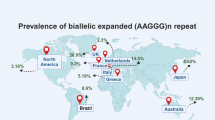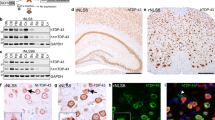Abstract
Autosomal dominant optic atrophy (adOA) is the most common form of hereditary optic neuropathy. The majority of cases are associated with mutations in the OPA1 gene. A few cases of adOA are known to be associated with moderate progressive hearing loss. To gain insight into the pathogenesis of this hearing loss, we performed expression analyses of OPA1 in the rat auditory and vestibular organ. In cochlear tissue, several splice variants of OPA1 were detected, which are also expressed in retinal tissue. OPA1 mRNA and protein was found in the hair cells and ganglion cells of the cochlea and vestibular organ. In ganglion cells, OPA1 mRNA and protein was already detectable at birth, whereas in the organ of Corti OPA1 mRNA and protein was up-regulated after birth and reached mature-like expression level during the onset of hearing. Comparison of an antibody directed to the mitochondrial marker protein HSP60 with antibodies directed to different amino acid stretches of OPA1 revealed a sub-cellular distribution of OPA1 in areas of significant density of mitochondria. The data suggest that defects in OPA1 cause hearing disorders due to a progressing metabolic disturbance of hair and ganglion cells in the inner ear.







Similar content being viewed by others
Abbreviations
- adOA:
-
Autosomal dominant optic atrophy
- OHC:
-
Outer hair cell
- IHC:
-
Inner hair cell
- VHC:
-
Vestibular hair cell
- SG:
-
Spiral ganglion cell
- VG:
-
Vestibular ganglion cell
- P:
-
Postnatal day
References
Aijaz S, Erskine L, Jeffery G, Bhattacharya SS, Votruba M (2004) Developmental expression profile of the optic atrophy gene product: OPA1 is not localized exclusively in the mammalian retinal ganglion cell layer. Invest Ophthalmol Vis Sci 45:1667–1673
Alavi MV, Bette S, Schimpf S, Schuettauf F, Schraermeyer U, Wehrl HF, Ruttiger L, Beck SC, Tonagel F, Pichler BJ, Knipper M, Peters T, Laufs J, Wissinger B (2007) A splice site mutation in the murine Opa1 gene features pathology of autosomal dominant optic atrophy. Brain 130:1029–1042
Alexander C, Votruba M, Pesch UE, Thiselton DL, Mayer S, Moore A, Rodriguez M, Kellner U, Leo-Kottler B, Auburger G, Bhattacharya SS, Wissinger B (2000) OPA1, encoding a dynamin-related GTPase, is mutated in autosomal dominant optic atrophy linked to chromosome 3q28. Nat Genet 26:211–215
Amati-Bonneau P, Odent S, Derrien C, Pasquier L, Malthiery Y, Reynier P, Bonneau D (2003) The association of autosomal dominant optic atrophy and moderate deafness may be due to the R445H mutation in the OPA1 gene. Am J Ophthalmol 136:1170–1171
Amati-Bonneau P, Guichet A, Olichon A, Chevrollier A, Viala F, Miot S, Ayuso C, Odent S, Arrouet C, Verny C, Calmels MN, Simard G, Belenguer P, Wang J, Puel JL, Hamel C, Malthiery Y, Bonneau D, Lenaers G, Reynier P (2005) OPA1 R445H mutation in optic atrophy associated with sensorineural deafness. Ann Neurol 58:958–963
Arnoult D, Grodet A, Lee YJ, Estaquier J, Blackstone C (2005) Release of OPA1 during apoptosis participates in the rapid and complete release of cytochrome c and subsequent mitochondrial fragmentation. J Biol Chem 280:35742–35750
Bette S, Schlaszus H, Wissinger B, Meyermann R, Mittelbronn M (2005) OPA1, associated with autosomal dominant optic atrophy, is widely expressed in the human brain. Acta Neuropathol (Berl) 109:393–399
Chen H, Chomyn A, Chan DC (2005) Disruption of fusion results in mitochondrial heterogeneity and dysfunction. J Biol Chem 280:26185–26192
Cipolat S, Martins de Brito O, Dal Zilio B, Scorrano L (2004) OPA1 requires mitofusin 1 to promote mitochondrial fusion. Proc Natl Acad Sci USA 101:15927–15932
Cone-Wesson B, Vohr BR, Sininger YS, Widen JE, Folsom RC, Gorga MP, Norton SJ (2000) Identification of neonatal hearing impairment: infants with hearing loss. Ear Hear 21:488–507
Delettre C, Lenaers G, Griffoin JM, Gigarel N, Lorenzo C, Belenguer P, Pelloquin L, Grosgeorge J, Turc-Carel C, Perret E, Astarie-Dequeker C, Lasquellec L, Arnaud B, Ducommun B, Kaplan J, Hamel CP (2000) Nuclear gene OPA1, encoding a mitochondrial dynamin-related protein, is mutated in dominant optic atrophy. Nat Genet 26:207–210
Delettre C, Griffoin JM, Kaplan J, Dollfus H, Lorenz B, Faivre L, Lenaers G, Belenguer P, Hamel CP (2001) Mutation spectrum and splicing variants in the OPA1 gene. Hum Genet 109:584–591
Dumont RA, Lins U, Filoteo AG, Penniston JT, Kachar B, Gillespie PG (2001) Plasma membrane Ca2+-ATPase isoform 2a is the PMCA of hair bundles. J Neurosci 21:5066–5078
Eatock RA, Rusch A, Lysakowski A, Saeki M (1998) Hair cells in mammalian utricles. Otolaryngol Head Neck Surg 119:172–181
Eggermont JJ (1986) Defining and determining sensitive periods. Acta Otolaryngol Suppl 429:5–9
Engel J, Braig C, Ruttiger L, Kuhn S, Zimmermann U, Blin N, Sausbier M, Kalbacher H, Munkner S, Rohbock K, Ruth P, Winter H, Knipper M (2006) Two classes of outer hair cells along the tonotopic axis of the cochlea. Neuroscience 143:837–849
Frezza C, Cipolat S, Martins de Brito O, Micaroni M, Beznoussenko GV, Rudka T, Bartoli D, Polishuck RS, Danial NN, De Strooper B, Scorrano L (2006) OPA1 controls apoptotic cristae remodeling independently from mitochondrial fusion. Cell 126:177–189
Goldberg JM (1996) Transmission between the type I hair cell and its calyx ending. Ann NY Acad Sci 781:474–488
Granse L, Bergstrand I, Thiselton D, Ponjavic V, Heijl A, Votruba M, Andreasson S (2003) Electrophysiology and ocular blood flow in a family with dominant optic nerve atrophy and a mutation in the OPA1 gene. Ophthalmic Genet 24:233–245
Griparic L, van der Wel NN, Orozco IJ, Peters PJ, van der Bliek AM (2004) Loss of the intermembrane space protein Mgm1/OPA1 induces swelling and localized constrictions along the lengths of mitochondria. J Biol Chem 279:18792–18798
Guan K, Farh L, Marshall TK, Deschenes RJ (1993) Normal mitochondrial structure and genome maintenance in yeast requires the dynamin-like product of the MGM1 gene. Curr Genet 24:141–148
Hoyt CS (1980) Autosomal dominant optic atrophy. A spectrum of disability. Ophthalmology 87:245–251
Hurley KM, Gaboyard S, Zhong M, Price SD, Wooltorton JR, Lysakowski A, Eatock RA (2006) M-like K+ currents in type I hair cells and calyx afferent endings of the develo** rat utricle. J Neurosci 26:10253–10269
Ishihara N, Fujita Y, Oka T, Mihara K (2006) Regulation of mitochondrial morphology through proteolytic cleavage of OPA1. Embo J 25:2966–2977
Jaeger W (1954) [Hereditary optic atrophy with dominant transmission; with special reference to the associated color-sense disorder]. Albrecht Von Graefes Arch Ophthalmol 155:457–484
Johnston PB, Gaster RN, Smith VC, Tripathi RC (1979) A clinicopathologic study of autosomal dominant optic atrophy. Am J Ophthalmol 88:868–875
Kennedy HJ (2002) Intracellular calcium regulation in inner hair cells from neonatal mice. Cell Calcium 31:127–136
Kharkovets T, Hardelin JP, Safieddine S, Schweizer M, El-Amraoui A, Petit C, Jentsch TJ (2000) KCNQ4, a K+ channel mutated in a form of dominant deafness, is expressed in the inner ear and the central auditory pathway. Proc Natl Acad Sci USA 97:4333–4338
Kjer B, Eiberg H, Kjer P, Rosenberg T (1996) Dominant optic atrophy mapped to chromosome 3q region. II. Clinical and epidemiological aspects. Acta Ophthalmol Scand 74:3–7
Knipper M, Bandtlow C, Gestwa L, Kopschall I, Rohbock K, Wiechers B, Zenner HP, Zimmermann U (1998) Thyroid hormone affects Schwann cell and oligodendrocyte gene expression at the glial transition zone of the VIIIth nerve prior to cochlea function. Development 125:3709–3718
Knipper M, Zinn C, Maier H, Praetorius M, Rohbock K, Kopschall I, Zimmermann U (2000) Thyroid hormone deficiency before the onset of hearing causes irreversible damage to peripheral and central auditory systems. J Neurophysiol 83:3101–3112
Krizaj D (2005) Serca isoform expression in the mammalian retina. Exp Eye Res 81:690–699
Lee YJ, Jeong SY, Karbowski M, Smith CL, Youle RJ (2004) Roles of the mammalian mitochondrial fission and fusion mediators Fis1, Drp1, and Opa1 in apoptosis. Mol Biol Cell 15:5001–5011
Li C, Kosmorsky G, Zhang K, Katz BJ, Ge J, Traboulsi EI (2005) Optic atrophy and sensorineural hearing loss in a family caused by an R445H OPA1 mutation. Am J Med Genet A 138:208–211
Lim DJ (1986) Functional structure of the organ of Corti: a review. Hear Res 22:117–146
Lorenz B (1994) Hereditary optic atrophy. Ophthalmologe 91:831–850
Lyle WM (1990) Genetic risks. University of Waterloo Press, Waterloo
Misaka T, Miyashita T, Kubo Y (2002) Primary structure of a dynamin-related mouse mitochondrial GTPase and its distribution in brain, subcellular localization, and effect on mitochondrial morphology. J Biol Chem 277:15834–15842
Olichon A, Emorine LJ, Descoins E, Pelloquin L, Brichese L, Gas N, Guillou E, Delettre C, Valette A, Hamel CP, Ducommun B, Lenaers G, Belenguer P (2002) The human dynamin-related protein OPA1 is anchored to the mitochondrial inner membrane facing the inter-membrane space. FEBS Lett 523:171–176
Olichon A, Baricault L, Gas N, Guillou E, Valette A, Belenguer P, Lenaers G (2003) Loss of OPA1 perturbates the mitochondrial inner membrane structure and integrity, leading to cytochrome c release and apoptosis. J Biol Chem 278:7743–7746
Payne M, Yang Z, Katz BJ, Warner JE, Weight CJ, Zhao Y, Pearson ED, Treft RL, Hillman T, Kennedy RJ, Meire FM, Zhang K (2004) Dominant optic atrophy, sensorineural hearing loss, ptosis, and ophthalmoplegia: a syndrome caused by a missense mutation in OPA1. Am J Ophthalmol 138:749–755
Pelloquin L, Belenguer P, Menon Y, Ducommun B (1998) Identification of a fission yeast dynamin-related protein involved in mitochondrial DNA maintenance. Biochem Biophys Res Commun 251:720–726
Pesch UE, Fries JE, Bette S, Kalbacher H, Wissinger B, Alexander C, Kohler K (2004) OPA1, the disease gene for autosomal dominant optic atrophy, is specifically expressed in ganglion cells and intrinsic neurons of the retina. Invest Ophthalmol Vis Sci 45:4217–4225
Satoh M, Hamamoto T, Seo N, Kagawa Y, Endo H (2003) Differential sublocalization of the dynamin-related protein OPA1 isoforms in mitochondria. Biochem Biophys Res Commun 300:482–493
Schneider ME, Belyantseva IA, Azevedo RB, Kachar B (2002) Rapid renewal of auditory hair bundles. Nature 418:837–838
Shimizu S, Mori N, Kishi M, Sugata H, Tsuda A, Kubota N (2003) A novel mutation in the OPA1 gene in a Japanese patient with optic atrophy. Am J Ophthalmol 135:256–257
Spicer SS, Thomopoulos GN, Schulte BA (1999) Novel membranous structures in apical and basal compartments of inner hair cells. J Comp Neurol 409:424–437
Starr A, Sininger YS, Pratt H (2000) The varieties of auditory neuropathy. J Basic Clin Physiol Pharmacol 11:215–230
Treft RL, Sanborn GE, Carey J, Swartz M, Crisp D, Wester DC, Creel D (1984) Dominant optic atrophy, deafness, ptosis, ophthalmoplegia, dystaxia, and myopathy. A new syndrome. Ophthalmology 91:908–915
Votruba M, Fitzke FW, Holder GE, Carter A, Bhattacharya SS, Moore AT (1998) Clinical features in affected individuals from 21 pedigrees with dominant optic atrophy. Arch Ophthalmol 116:351–358
Zhao Y, Yamoah EN, Gillespie PG (1996) Regeneration of broken tip links and restoration of mechanical transduction in hair cells. Proc Natl Acad Sci USA 93:15469–15474
Acknowledgments
The authors are grateful to Dr. Guy Lenears for providing the OPA1-II antibody and to Karin Rohbock for excellent technical assistance. We are very thankful for English revision of the manuscript by Dr. Rama Panford-Walsh. This work was supported by the Fritz Thyssen Stiftung für Wissenschaftsförderung, Köln, Germany and the Deutsche Forschungsgemeinschaft DFG KN316/4–1.
Author information
Authors and Affiliations
Corresponding author
Additional information
Stefanie Bette and Ulrike Zimmermann contributed equally to this work.
Rights and permissions
About this article
Cite this article
Bette, S., Zimmermann, U., Wissinger, B. et al. OPA1, the disease gene for optic atrophy type Kjer, is expressed in the inner ear. Histochem Cell Biol 128, 421–430 (2007). https://doi.org/10.1007/s00418-007-0321-7
Accepted:
Published:
Issue Date:
DOI: https://doi.org/10.1007/s00418-007-0321-7




